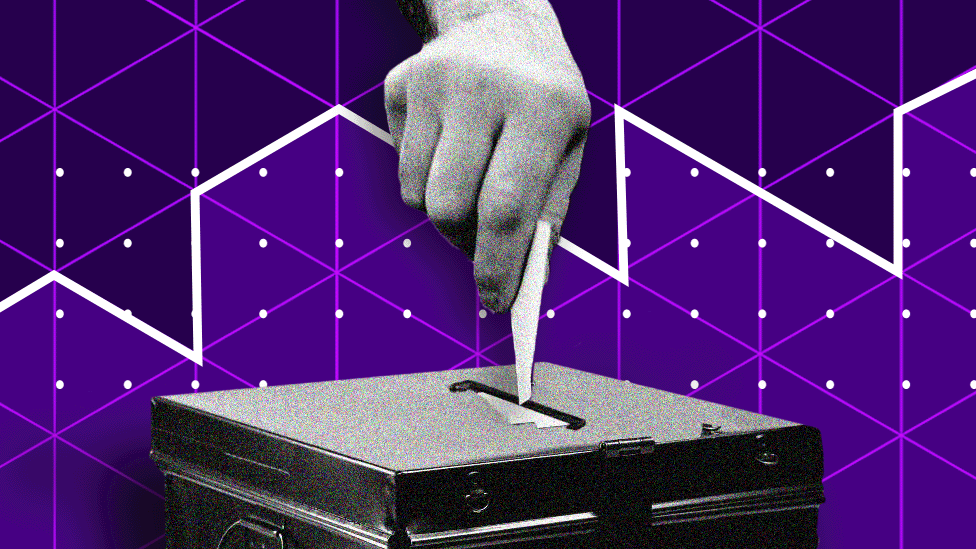General election 2024 poll tracker: How do the parties compare?

Use our interactive poll tracker to check the latest trends measuring how people say they intend to vote.
Click here to see the BBC interactive
If you can't see the chart, click here.
What do the latest polls tell us?
MPs have returned to Parliament from their Easter break. There have been no great changes to the opinion polls whilst they've been away, writes senior political analyst Peter Barnes.
Labour retain a commanding lead, about 20 points ahead of the Conservatives on average.
Reform UK are in third place, a bit ahead of the Lib Dems. Their average level of support is 12% compared with 13% last week.
Remember, the poll tracker is based on polls covering Great Britain overall and it's hard to tell from the national numbers how the SNP and Plaid Cymru are performing because they only contest seats in Scotland and Wales respectively.
And it doesn't cover Northern Ireland, where there are different political parties and very few polls are conducted.
How big are the gaps between parties?
All polls are based on a sample of people interviewed, typically more than 1,000, which is then weighted to be representative of the country.
There is always a margin of error, meaning the real percentage could be higher or lower than any one poll suggests.
We estimate that the true support for each party lies within the ranges shown here.
Click here to see the BBC interactive
Individual poll data is published online by the different companies.
Where a party has polled less than 0.5%, it is shown in the table below as 0 due to rounding down the numbers.
Click here to see the BBC interactive
What is a poll tracker?
Each dot in the chart shows one poll result for a party.
We summarise all that information with an average line that makes it easier to understand the trend.
Which polls do we use?
To get an appropriate range of polls for our averages, we use those conducted by members of the British Polling Council.
Its members agree to the same rules on transparency, but the council has said membership should not be seen as a guarantee of quality.
The polls we include have come from BMG, Deltapoll, Find Out Now, focaldata, Ipsos, JL Partners, More in Common, Opinium, Panelbase, People Polling, Redfield and Wilton Strategies, Survation, Techne, Verian (formerly Kantar Public), WeThink (formerly Omnisis), Whitestone Insight and YouGov.
We only include the headline percentages on voting intention, which pollsters calculate by excluding those people who answered "don't know" or "won't vote".
Most of the polls included cover Great Britain, although some do poll the whole of the UK. People surveyed do not get the option to choose parties which only stand in Northern Ireland.
We include data that is in the public domain. Some polling companies will not publish all data for all parties at the same time.
Who pays for polls?
Where polling companies have stated in their data tables who their client is, we have included this in our table. It is common for polling companies to do their work for news organisations, television programmes and campaign groups.
What is the margin of error?
The true position for the Conservatives and Labour might be within five percentage points of our average.
Nine out of 10 polls just before election day have been within that range of the eventual national vote shares in the 2010 to 2019 general elections.
The gap has been smaller for other parties which campaign throughout Great Britain and smaller still for the SNP and Plaid Cymru.
How do we average the polls?
Our estimate of a party's support is a rolling average of polls.
A party's share on any given day is the average of their results from polls taken over the previous fortnight. We only take the most recent poll from each company for that day's averages.
Why do polling companies have different results?
All opinion polls will differ a bit because they are interviewing different people. There are also other things that can lead to differences between polling companies. For example:
Different companies find the people who take part in their polls in different ways
The precise wording of the question varies between pollsters, and some pollsters ask more than one question to reach their voting intention figures
Pollsters apply "weights" to their data to try to make their results reflect the make-up of the voting population. So if a particular poll has a smaller proportion of female respondents than there are in the wider population, their responses will be given extra weight in the final results. But different companies take different factors into account
The companies have different ways of treating people who initially say they do not know how they will vote, or are not certain if they will vote.
What do pollsters ask?
For voting intention, polling companies typically ask interviewees a question along the lines of: "If a general election were held tomorrow, which party would you vote for?"
Some polling companies have not given their interviewees the choice of some parties, including them within the "other" category.
For example, Reform UK, formerly the Brexit Party until 2021, has only been included as an option in every poll featured in our tracker since autumn 2022, while support for Plaid Cymru is included among "other" parties in polls released by Techne.
Produced by Grace Richardson, Scott Jarvis, Becky Rush, Allison Shultes, Libby Rogers, Daniel Wainwright, Aidan McNamee, Jana Tauschinski, Debie Loizou, Preeti Vaghela, Robert Cuffe, John Walton.

